India's Golden Age: Why Next 30 years will compound wealth for India?
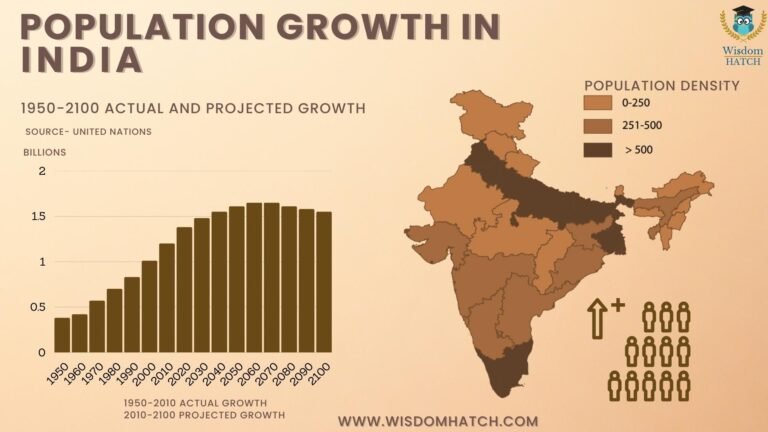
Introduction
Imagine settling in a foreign land, not for its exotic beaches or vibrant culture, but because you can live five times better than in your home country, while spending only half as much. This intriguing trend is sweeping Southeast Asia, with Americans leaving the U.S. to embrace life in countries like India.
As per the graphic below, the aggregated total balance sheet of the 5 biggest Central Banks in the world was around $5 trillion [1].
In the next 14 years, this number stands at almost $26 trillion. This is a whooping 420% increase.

This substantial move is hurting the developed nations a lot more than the emerging economies.
This blog explores the macroeconomic underpinnings of these phenomena and how it relates to India’s future prosperity.
In this journey through the next 30 years, we will answer key questions:
- Why is India set to grow economically?
- What role does population play in India’s future?
- How is India positioned to benefit from global productivity changes?
- Why is India an attractive investment destination for the next three decades?
The Productivity Equation
Historically, economic growth has hinged on two factors: an expanding workforce and rising productivity. This can be simplified as “population times productivity.”
From the Persian Empire’s dominance, driven by controlling a substantial portion of the world’s population, to the Roman Empire’s belief in annexing new lands for prosperity, this equation has held true.
In the contemporary context, this equation still applies. The United Nations projects a world population decline after 2050 [2].
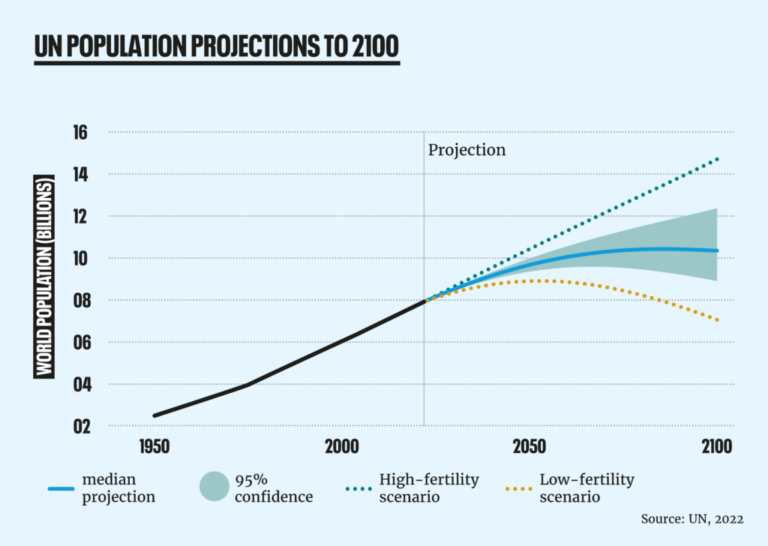
But India stands out as an exception.
As per the chart below [3], India’s population decline is only likely to happen post 2080.

India’s population growth is expected to continue well beyond that point, providing a significant window for economic expansion.
While there are global concerns about overpopulation, India’s demographic dividend presents an opportunity for growth.
Productivity Growth and India's Advantage
The world has witnessed three phases of significant growth: the era of trade and financial markets, the Industrial Revolution, and the current era of what we call “fake money” innovation.
This can be highlighted from the chart below [4].
The first phase of Trade and Financial Markets took place from around 1600-1650.
The second phase of the Industrial Revolution took place from 1750-1850.
And the current phase started at around the 1950s.
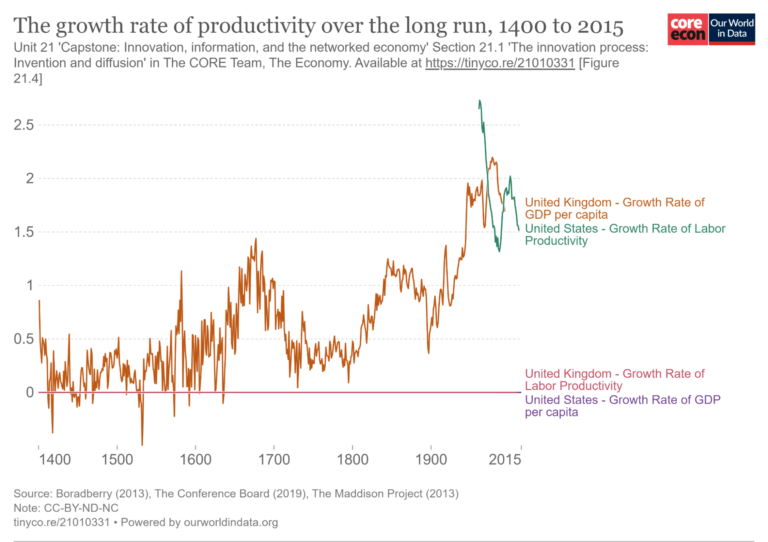
The era of trade and financial markets was marked by significant innovations such as the establishment of financial markets and cross-country trade, boosting global productivity. The Industrial Revolution, which originated in the UK, revolutionized manufacturing and increased productivity on a massive scale.
The current phase is characterized by the innovation of “fake money.” This trend started when the U.S. moved away from the gold standard in the 1970s. While some might question the authenticity of this innovation, it has indeed added to productivity by increasing the velocity of money. Governments and central banks have been using this “makeup” on the economy to make it more attractive and stimulate growth.
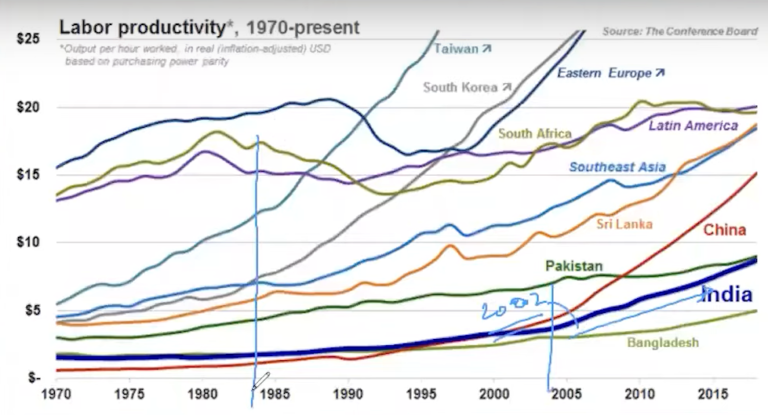
India’s productivity started to rise after 2002-2003, somewhat later than in Western countries that benefited from the creation of fake money.
Now, with increased sustained inflation due to money printing, investors are seeking higher returns and are willing to take on more significant risks.
This leads to more money flowing into emerging economies like India, where the potential for returns that outpace inflation is appealing.
Investor's Goal: Beat Inflation
Investors worldwide share a common objective: beating inflation. As inflation surges due to money printing, the challenge intensifies. Even top mutual funds struggle to outperform inflation. Hence, investors are looking to emerging markets to achieve this goal.
India's Attractiveness for Investment
This point can be better understood by looking at the FDI Investments in India [6].
As per the chart, in the 2000s India’s FDI Investment was around INR 4029 crores. In the next 5 years this number doubled to almost INR 9000 crores.
This was followed by a period of stagnation due to the Financial Crisis in 2008. Then again from 2014, this trend continued to grow.
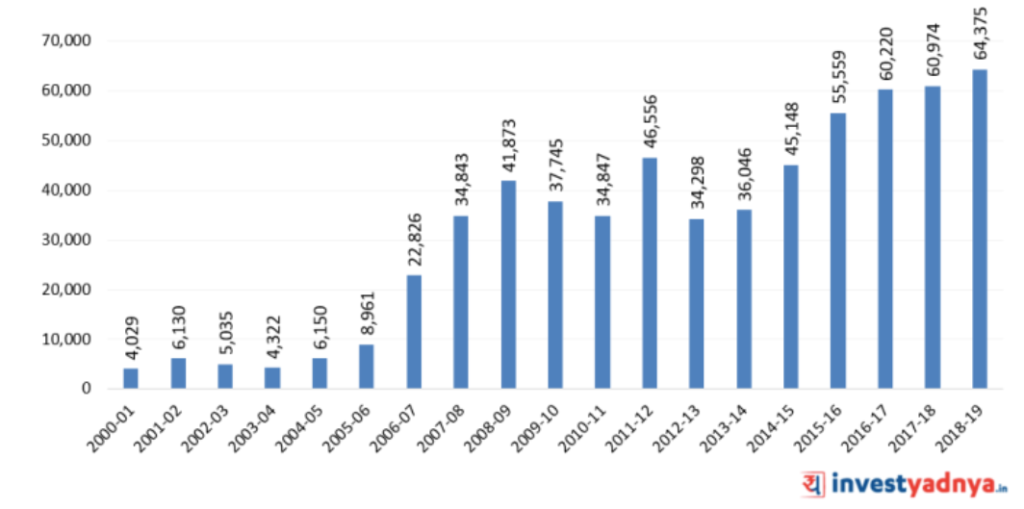
India’s FDI investments reflect its attractiveness as an investment destination.
During calm economic periods, money flows into emerging markets, making India an appealing option. In recent years, India has produced numerous unicorns, thanks to this capital influx.
According to Global Unicorn Index 2023, India ranks 3rd on the most number of Unicorns [7].

Key Catalysts for India's Prosperity
To spur innovation and economic growth, catalysts are essential. India has seen a surge in internet adoption, with one of the world’s highest rates. Internet penetration is reaching even the remotest corners of the country, opening up new markets and opportunities.
Internet Penetration in India has grown exponentially and is set to continue this pace going forward [8][9].

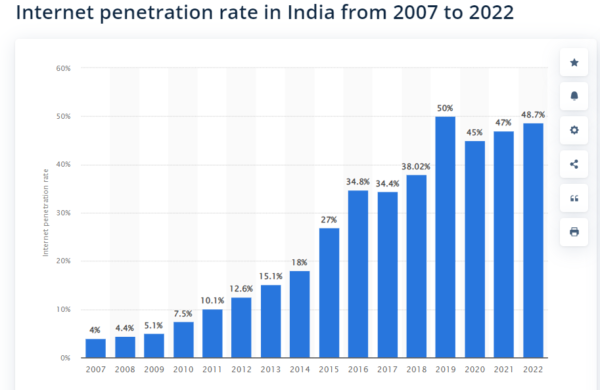
Additionally, the adoption of digital payment methods, like UPI 2.0, is changing consumer behavior. People are saving less and spending more, contributing to economic growth. This shift mirrors global trends where consumeristic cultures tend to lead to higher GDP growth.
As per the chart below [10], the volume of UPI based payments in India has almost doubled consistently every year since its introduction.

In the past, India was known as a nation of savers. However, this is changing rapidly, and it’s not just about spending but also about the efficiency of spending. Digital payment innovations are reducing transaction friction, leading to more consumption and economic growth.
If you are a serious investor and are looking for advanced techniques with a focus on better returns, join my Youtube Community where I give live and timely updates on the Stock Market.
Conclusion
India is poised for a golden age in the next 30 years. Its population growth and increased productivity align with global economic shifts, making it an attractive investment destination. With the world’s focus on beating inflation, India’s potential for strong returns becomes evident.
As you plan your investment strategy, consider India’s promising future. Embrace its potential and be part of India’s journey to prosperity in the next three decades. In this ever-evolving global landscape, India shines as a beacon of economic opportunity and growth.
- Americans and other foreigners are moving to countries like India for a higher quality of life at lower costs.
- Central bank balance sheets globally are set to increase by 420% in the next 14 years, impacting developed nations more than emerging economies.
- India’s economic growth is attributed to its population and rising productivity.
- India’s population is expected to continue growing, offering an opportunity for economic expansion.
- India’s productivity has increased, particularly after 2002-2003, attracting investment as inflation rises.
- Investors are seeking to beat inflation and are turning to emerging markets like India.
- FDI investments in India have been on the rise, reflecting its appeal as an investment destination.
- India’s growth is fueled by catalysts like internet adoption and the shift towards digital payments.
- India is well-positioned for economic prosperity in the next 30 years, making it an attractive investment option in the face of global economic shifts
[1] https://fingfx.thomsonreuters.com/gfx/rngs/GLOBAL-CENTRALBANKS/010041ZQ4B7/index.html
[2] https://populationmatters.org/news/2023/01/the-world-of-population-projections/
[3]https://ichef.bbci.co.uk/news/624/mcs/media/images/68183000/gif/_68183711_population_624.gif
[4] https://ourworldindata.org/grapher/the-growth-rate-of-productivity-over-the-long-run-14002009
[5] https://www.conference-board.org/publications/Global-Labor-Productivity2022
[6] https://blog.investyadnya.in/historical-trend-of-indias-fdi-inflows/
Ever wondered what we get in return for the taxes we pay in India. Whether the Tax Structure is TOXIC? Check out our Blog post on HEAVY TAXES, But we get NOTHING in return
MUST know BEFORE you become an Airbnb host
Medium Article Preksha Chand edit post MUST know BEFORE you become an Airbnb host Medium Article Preksha Chand edit post MUST know BEFORE you become an Airbnb host Medium...
Make more money from your property: Short-term rental [Airbnb]
Medium Article Preksha Chand edit post Make more money from your property: Short-term rental [Airbnb] Medium Article Preksha Chand edit post Make more money from your property: Short-term rental...
GOA Airbnb Laws: What Hosts Need to Know [2024]
Medium Article Preksha Chand edit post Make more money from your property: Short-term rental [Airbnb] Medium Article Preksha Chand edit post Make more money from your property: Short-term rental...





